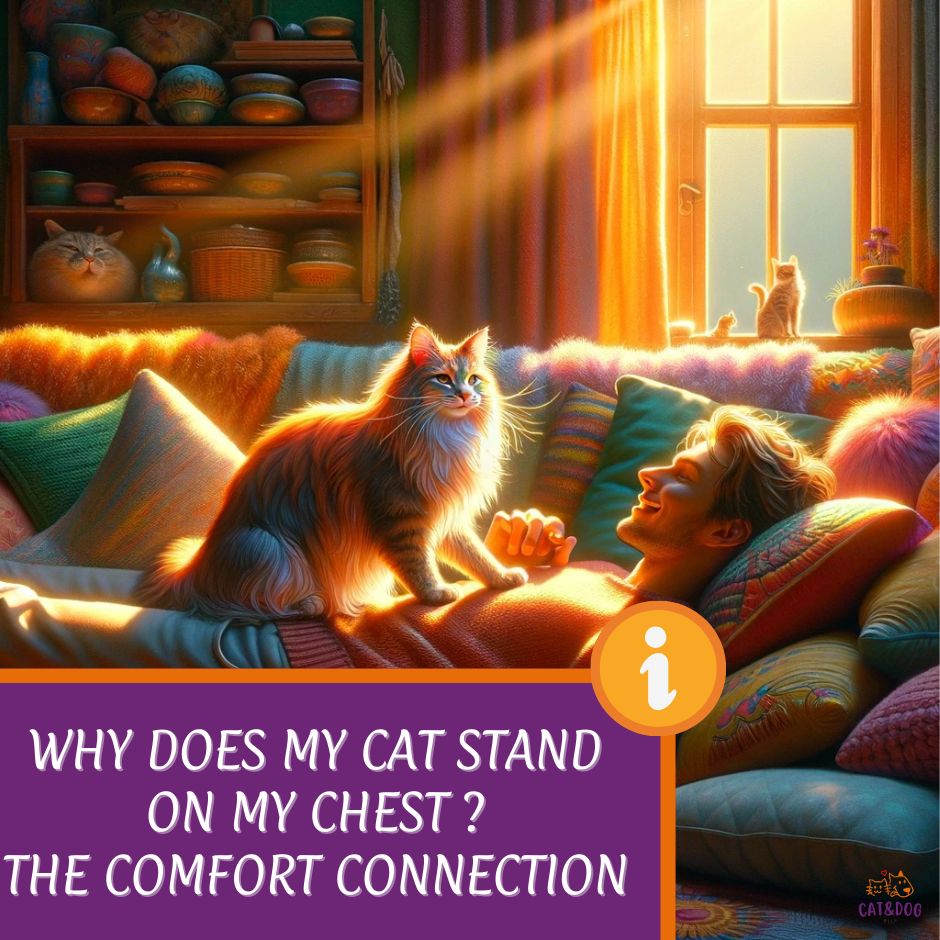Cats seem to have a fondness for perching on human chests, claiming their territory, and asserting their dominance over other household pets with the help of their scent glands.
This behavior, known as “owner’s chest sleeping,” provides a unique bonding opportunity for cats and their owners, as they can form strong emotional attachments through touch.
This phenomenon, also known as the #1 Bonding Opportunity, has been studied and documented in the Current Biology Journal, further uncovering the mystery behind why cats choose to stand on their owner’s chest every night.
This behavior not only allows for physical closeness but also provides a sense of security and comfort for both the cat and their owner, making it a cherished bonding experience for both parties.

As odd as it may seem, cats standing or laying on their owner’s chest is a common behavior.
It’s driven by various factors that are rooted in their instincts and their emotional connection with you.
This curiosity might have nudged you to question, “Why does my cat stand on my chest?” Whether it’s for warmth, security, affection, solace, or a mix of reasons.
Understanding the “why” can strengthen the bond with your lovable feline, especially for comfort seekers.
Through this article, we’ll uncover the motivations behind this endearing habit and how it reflects on your relationship, ultimately guiding you in navigating this trait for a happy, healthy coexistence.
Additionally, this behavior can also release the “feel good” hormone oxytocin, creating a positive and loving bond between you and your kitten. (1)
So, the next time your kitten stands on your chest, take solace in the fact that they are seeking comfort and warmth from you, which can also provide warmth and relaxation for their muscles, tendons, and joints.
Key Takeaways
- Cats often stand on chests for comfort, as a sign of affection, and to feel secure.
- Understanding this behavior can enhance the emotional bond between you and your pet.
- Knowing how to respond ensures the health and comfort of both the cat and the owner.
Understanding Why Does My Cat Stand on My Chest

It’s pretty heartwarming once you understand the whys behind it.
The Basics of Cat Behavior Cats are creatures of habit and instinct, and they’ve got a few behaviors hardwired into their cute little brains:
- Territory:
Cats mark their territory, and what better place than on you, their favorite human? - Hunting:
They might not be hunting while snoozing on you, but they’re certainly keeping their instincts sharp by staying close to a trusted ally – you! - Social behaviors:
Contrary to the lone hunter stereotype, cats can be social butterflies with those they trust. (2)
So, why the chest? Cats show affection and trust in unique ways:
- Kneading: Feels like a mini massage, right? It’s a sign they adore you.
- Purring: This little engine of love not only shows contentment but can also be healing!
- Proximity: Cats crave warmth and safety, and your chest is the VIP lounge for both.
Scientific Insights into Feline Behavior Research keeps uncovering fascinating facts about our whiskered companions:
- Studies by associations like the American Veterinary Medical Association show cats have complex ways of communicating with us, often choosing to stay close to those they trust.
- According to vets and animal behaviorists, standing on your chest can be your cat’s way of saying, “Hey, you’re my person.”
So next time your cat decides you’re the best seat in the house, remember it’s their quirky, special way to say, “I love you!” Isn’t that right, Dr. Whiskers?
The Emotional Bond Between You and Your Cat
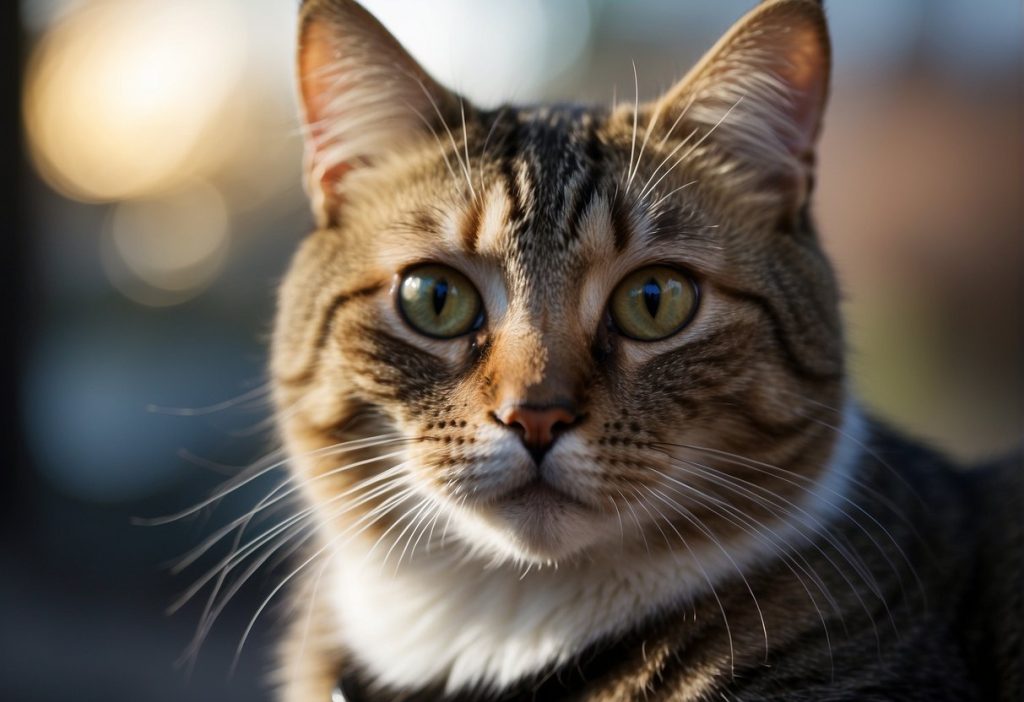
Beyond seeking a cozy spot, your cat is expressing trust and affection, seeking companionship and warmth from you through chemical messages.
Cats, like us, have unique ways of showing love. When they stand on your chest, it’s comparable to other behaviors such as head-bunting or slow blinking.
However, if you find it uncomfortable or the behavior is becoming repetitive, redirect them onto a warm comfortable bed or one of your old t-shirts that smells like you to continue exchanging chemical messages.
Specifically through scent marking, and promoting the emotional bond between you and your cat through cat sleep, as they are territorial creatures by nature.
- Head-Bunting: You know, that gentle nudge with their forehead? It’s like a kitty kiss!
- Slow Blinking: Those soft, trusting eye-closures? They’re saying, “I’m comfortable with you.”
Strengthening Your Bond:
- Playtime:
Grab that laser pointer, and let the games begin! Engaging in play satisfies their hunting instincts and builds their bond. - Responsive Petting:
Pay attention to their reactions, and you’ll soon learn their favorite petting zones.
Your cat finds comfort in your presence, which eases their anxiety. It’s akin to a child clutching a security blanket; your proximity is reassuring.
For Your Feline’s Emotional Well-Being:
- Offer them a haven, like a cozy nook near your usual sitting area.
- Be consistent with your responses. If you enjoy their chest-standing sessions, reward them with pets and kind words.
Tips for a Positive Co-existence:
- Use soft tones; abrupt changes in your demeanor can send mixed signals to your sensitive companion.
- Recognize the signs of contentment: a purring motor or kneading paws are signals you’re doing it right!
In nurturing the connection with your cat, you create a mutually beneficial emotional oasis. A little comfort in the chaos, courtesy of our feline friends.
Health Considerations for Cat and Owner
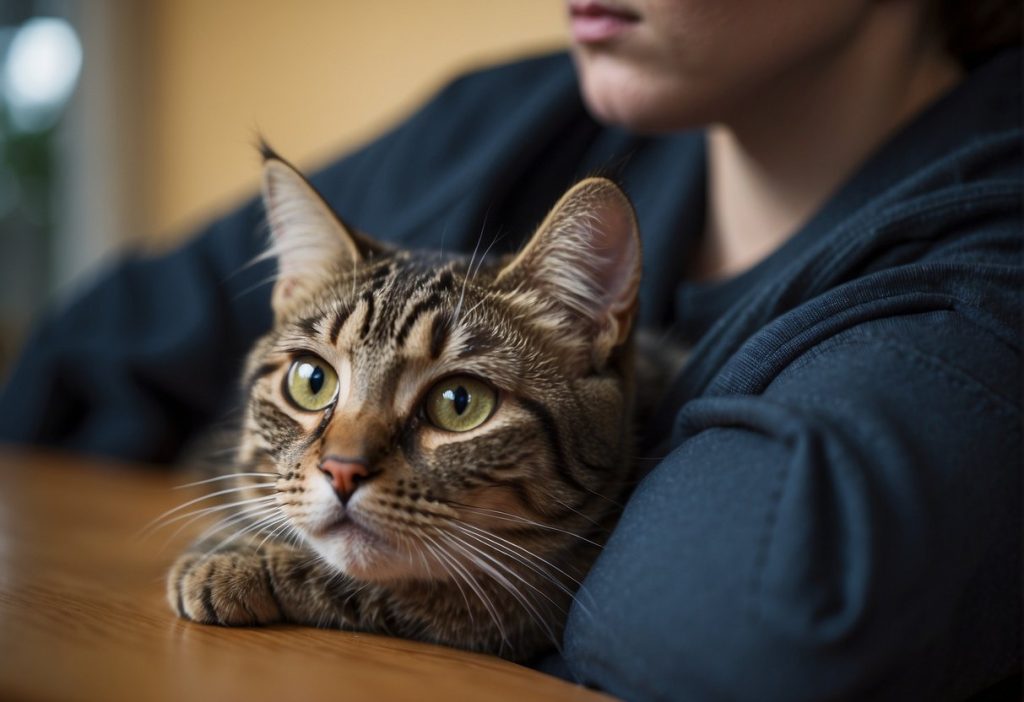
Recognizing Health Signals in Your Cat’s Behavior
Sometimes, it’s a telltale sign of health issues. Cats might seek the warmth and comfort of your chest due to various conditions:
- Arthritis:
This joint pain can make your lap seem like the perfect refuge for a sore kitty. (3) - Hyperthyroidism:
A cat with thyroid problems may exhibit increased body temperature, causing them to seek out your warmth. (4)
Surprisingly, arthritis affects up to 3 in 10 cats, while hyperthyroidism touches around 2 in 10 senior cats.
Keep an eye out for your cat’s signals, and if you notice odd behavior like restlessness, excessive purring, or continual chest standing, a vet check-up might be in order.
Understanding the Impact on Human Health
Let’s not pussyfoot around the potential risks:
- Allergies: The close contact can trigger sneezes and sniffles if you’re allergic. (5)
- Respiratory Issues: Cat dander and fur might exacerbate conditions like asthma. (6)
To nurture a healthy environment for both of you, consider these pointers:
- Groom Your Cat Regularly: It keeps shedding under control.
- Invest in Air Filtration: A good air purifier can work wonders.
Remember, staying alert to these health considerations ensures that chest time remains a heartwarming bonding moment, purr-fectly safe for both you and your whiskered companion!
Navigating and Responding to the Behavior
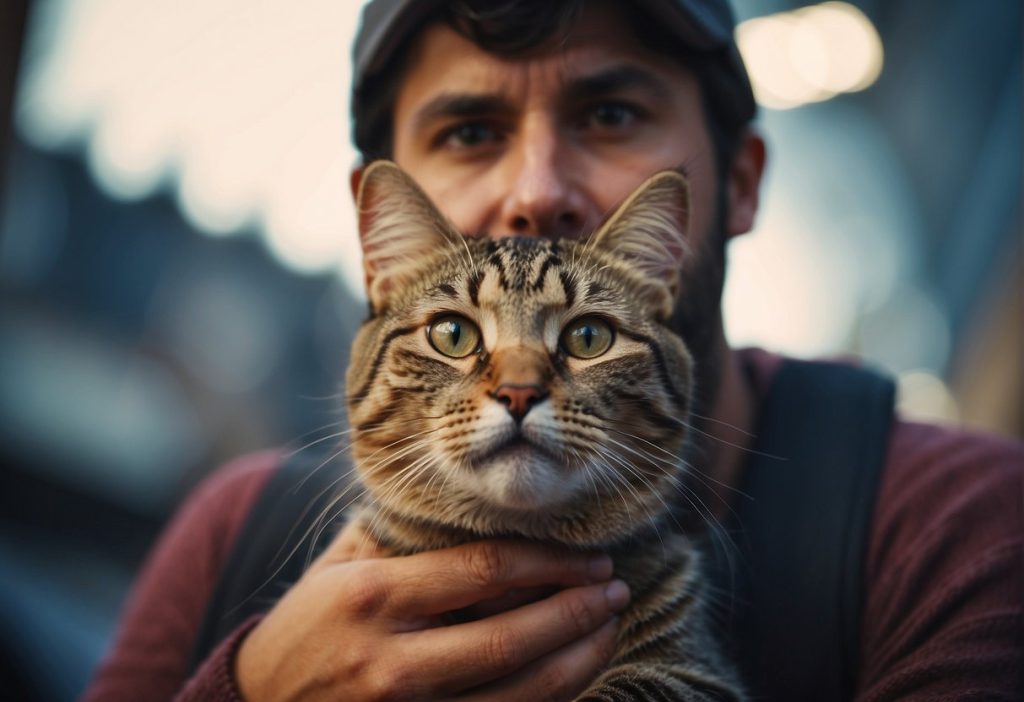
Encouraging Healthy Behaviors:
Positive reinforcement is your best friend here. Every time your cat chooses not to stand on your chest, give them a treat or some extra cuddles. You can:
- Use treats: Keep them handy to reward good behavior.
- Try clicker training: A click indicates the right behavior, followed by a reward.
- Praise: A simple “good kitty” goes a long way.
Wondering about setting up a cozy nook? Try these setups:
- A soft bed by the window.
- A cat tree with a prime viewing spot.
- A warm blanket in a quiet corner.
Practical Alternatives for Expressing Affection:
Cats need engagement, and you need to not be a cat stand. Balance is key. Bring in toys that’ll take your cat’s mind off turning you into a throne, such as:
- Feather wands
- Laser pointers
- Puzzle feeders
Boundaries? Yes, you need them. How?
- Be consistent: If chest-standing is a no-go, it’s always a no-go.
- Gentle redirection: Move your cat to their spot every time they try it.
Remember, it’s all about creating a loving environment where you and your kitty can enjoy each other’s company on mutual terms. Have fun experimenting!
Practical Tips for Cat Owners

Let’s talk about making your cat feel secure without sacrificing your personal space.
Create a Comfy Alternative:
- Cat Trees:
Invest in a sturdy cat tree placed near your favorite sitting area. Cats love high vantage points, and this might just be the new go-to spot! - Cozy Beds:
Designate a special bed for your cat in the same room where you relax. A bed with raised edges can mimic the enclosed feeling they seek on your chest.
Set Boundaries With Love:
- Start by gently placing your cat onto their new spot every time they climb on you.
- Pair the action with a soothing voice or a treat to create a positive association.
Real-Life Success: Jackie, a cat owner from Austin, says, “My cat, Whiskers, always stood on my chest during my TV time.
I Got her a cat bed, placed it next to me, and every time she climbed on me, I’d move her to the bed and pet her.
Two weeks later, Whiskers has made the bed her new throne! To further encourage positive behavior, try placing something of yours in the bed, such as a t-shirt or their favorite toy.
The familiar scent will ease them and help them feel comfortable and safe at night. Another option is to provide cardboard boxes for your cat to use as a cozy hiding spot or bed.
Many cats are naturally drawn to cardboard boxes for comfort and warmth, making it a practical and affordable option for cat owners to maintain their cat’s physical health and emotional well-being in recent years.
As cat owners, it is important to prioritize our feline friends’ physical and emotional health and provide them with comfortable and safe options for relaxation, such as a litter box. (3)
Additionally, regularly checking in on your cat’s emotional well-being and providing them with love and attention can greatly improve their overall happiness and quality of life in recent years.
If you notice your cat is avoiding their litter box, it could be a sign of stress or anxiety. Be sure to address any potential triggers and provide a comfortable and accessible litter box for your cat to use.
Remember, changes don’t happen overnight. Be patient and consistent with your efforts.
Quick Recap
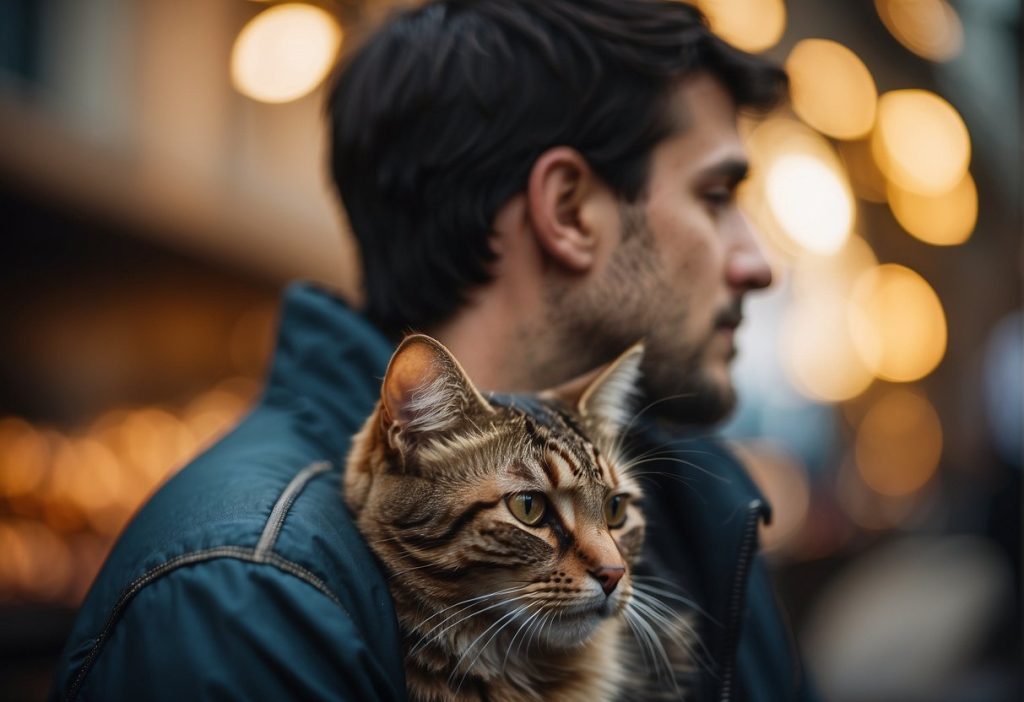
It’s all about comfort, security, and that special bond they share with you. Remember, cats are heat-seekers, and your chest is warmer during those chilly evenings.
Here’s a quick rundown of those adorable reasons:
- Safety First: Your chest provides a safe platform, away from the hustle and bustle of the floor-level life.
- Love and Affection: Those little head rubs aren’t just cute, they’re signs of trust and affection.
- Heat-Seeking Missions: Cats love warmth, and your body heat is simply irresistible.
Observing these behaviors is more than just cute; it’s a window into your cat’s soul. Take note of their tendencies—like that 70% of their life spent napping—and respond with gentle strokes and soft words.
Here’s what you should keep an eye on:
- Sense of Security: Cats find the rhythm of your heartbeat soothing.
- Possessiveness: Your lap isn’t just a lap, it’s their territory.
- Managing Aches: Your soft chest might also be a remedy for their achy joints.
Share your stories and pointers on cat-chest diplomacy with fellow cat owners. Let’s keep the conversation going!
Frequently Asked Questions
Let’s jump into some of the most common questions to help you understand this quirky behavior.
Why does my cat specifically choose my chest to stand on?
Your chest provides a combination of warmth, the reassuring sound of your heartbeat, and a sense of security. Cats often seek out cozy, welcoming places, and your chest fits the bill perfectly.
Is it normal for cats to stand on their owners?
Absolutely! It’s typical for cats to stand on or near their owners as it’s a sign of trust and affection. Think of it as a feline version of a hug or snuggle.
Can this behavior indicate a health issue in my cat?
Standing on your chest usually isn’t a sign of health problems. However, if this behavior is sudden and accompanied by other unusual signs, it could warrant a vet visit to rule out any underlying issues.
What are some alternative ways my cat can show affection?
Cats can express affection through head bunting, purring around you, slow blinking, or even just choosing to be near you. It’s their way of saying “I love you” without standing on your chest.
Could my cat’s chest-standing behavior be harmful to me?
Typically, a cat standing on your chest isn’t harmful unless the weight causes discomfort or you have an existing medical condition that makes this kind of pressure dangerous.
How can I create a comfortable alternative spot for my cat?
Set up a cozy bed or blanket in a spot near where you relax. Encourage your cat to use it by placing treats or their favorite toy there, making it an irresistible resting spot just for them.
- The Ultimate Overview to Actual Cash Gambling Establishments - July 1, 2025

